Last Updated on October 30, 2024 by Owen McGab Enaohwo
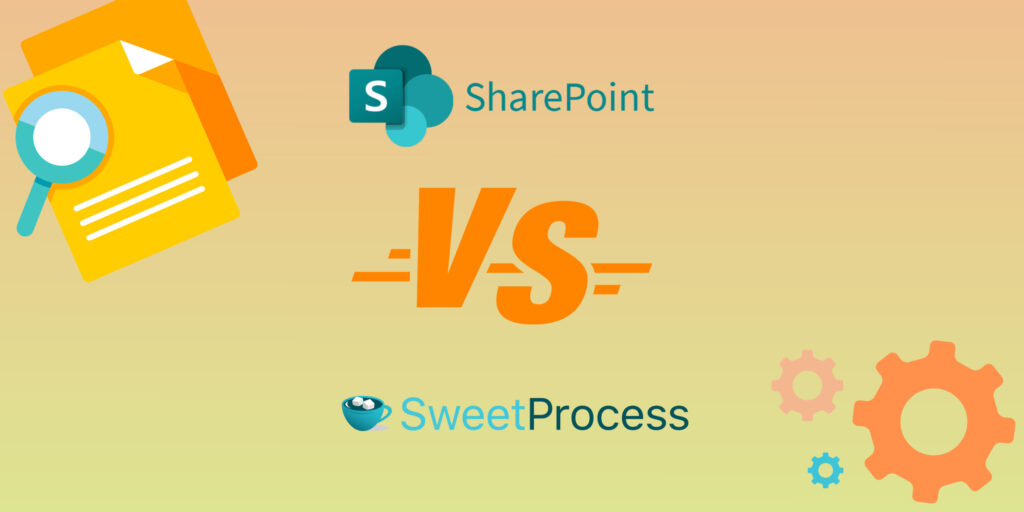
Are you in a situation where SharePoint has left you wanting more?
SharePoint is not a bad tool per se, and most companies have a version of it. However, it will not provide your company with customized policy, process, and procedure management.
SweetProcess is more geared toward helping track those kinds of documentation. SharePoint is a bit more like an internal website for large organizations. It’s overkill for smaller ones.
SharePoint’s costs, complexity, integration bias toward Microsoft products, and even outdated interface, as rightly stated by an online reviewer, make people seek alternatives geared toward their specific needs.
If you are looking for a simpler, more cost-effective, more intuitive, and user-friendly solution that better aligns with your specific needs, offers seamless integration, and provides a more tailored user experience, Sweetprocess is the best SharePoint alternative you can find.
Don’t take our word for it, however. Give SweetProcess a try to experience first-hand what over 40,000 other users enjoy and see if it meets your business documentation needs.
The good news is that you can try SweetProcess for 14 days without any commitment, not even your credit card. Simply click here to get started now.
However, here’s a comparison of both platforms to help you decide between SharePoint and SweetProcess.
Table of Contents
An Overview of SharePoint vs. SweetProcess
Documenting Policies on SharePoint vs. SweetProcess
Documenting Processes on SharePoint vs. SweetProcess
Documenting Procedures on SharePoint vs. SweetProcess
Why Organizations Choose SweetProcess Over SharePoint
SharePoint vs. SweetProcess: An Overview
This article aims to analyze how both SharePoint and SweetProcess compare generally, and then in terms of documenting and managing policies, processes, and procedures.
In this first chapter, we overview these platforms to compare them generally to see how they stack up against each other.
Let’s start with SharePoint.
What is SharePoint?

Image credit: Microsoft
SharePoint is Microsoft’s comprehensive collaboration and document management platform. It is a centralized hub for teams in organizations to securely create, store, share, and manage various types of content, documents, applications, and data.
SharePoint offers tools and features designed to improve teamwork, streamline communication, and help teams share information efficiently within an organization.
What Are the Features of SharePoint?

SharePoint enables teams to manage content and automate processes through the following features:
1. SharePoint gives organizations access to robust document management functionalities that ensure that documents are organized, secure, and easily accessible. This includes version control, co-authoring, check-in/check-out, and metadata tagging.
2. With features like document sharing, comments, and notifications, teams can collaborate on documents and projects within SharePoint in real time.
3. Organizations can design and automate business processes using SharePoint workflows, which help to streamline approvals, notifications, and tasks.
4. SharePoint integrates seamlessly with Microsoft Office applications such as Word, Excel, PowerPoint, and Outlook. This enables users to work on documents and content directly within SharePoint.
5. SharePoint allows users to create team sites and portals for different teams, projects, or departments, to serve as dedicated spaces for content storage, collaboration, and communication.
6. With SharePoint’s powerful search functionality, users can use full-text, metadata-based, and even custom search to quickly find anything, including content, documents, and people profiles.
7. Users can create interactive dashboards, reports, and data visualizations by integrating SharePoint with PowerBI.
8. With SharePoint’s fine-grained security controls, administrators can set individual, group, or site permissions. It also supports encryption, data loss prevention, and information rights management.
9. SharePoint has dedicated mobile apps through which users can access and collaborate on documents.
10. With SharePoint’s external sharing capabilities, organizations can securely share content with external users, such as clients or partners, while maintaining control over permissions.
11. SharePoint provides tools for building custom applications and solutions using SharePoint’s APIs, including SharePoint Framework (SPFx) for modern web development.
12. You can customize SharePoint to match your organization’s branding and design to create a consistent user experience using custom themes, templates, and page layouts.
These features – and more – make SharePoint a versatile platform for collaboration, content management, and improving an organization’s business processes generally.
Based on these features, here are some of the pros and cons of SharePoint:
Pros of SharePoint
- Comprehensive collaboration and document management platform.
- Customizable to fit your organization’s needs and branding.
- Seamless integration with Microsoft Office applications.
- Powerful search capabilities to find files quickly and easily.
- Robust security features to control sensitive information.
- Compliance tools to help organizations meet regulatory requirements.
- Mobile apps for easier access.
- Secure external sharing for collaboration with external parties.
- Workflow capabilities help automate business processes and improve efficiency.
Cons of SharePoint

- SharePoint’s extensive features may lead to a steep learning curve for users.
- Complex customizations might require skilled developers.
- Some users may find the platform overwhelming, leading to a low user adoption rate.
- SharePoint’s dependency on Microsoft Ecosystem might limit integration with third-party tools and external systems.
- Licensing and maintenance costs can be substantial, based on the model deployed and the customization required.
- Upgrading and migrating from older to newer SharePoint versions can be complex.
- Organizations using SharePoint Server may require dedicated IT resources for maintenance and updates.
- Customizing the user interface may lead to inconsistent user experience across devices.
Now that you have SharePoint’s features, pros, and cons, it is essential to carefully assess them to determine if SharePoint fits your organization’s needs.
Next, let’s take a look at SweetProcess.
What Is SweetProcess?
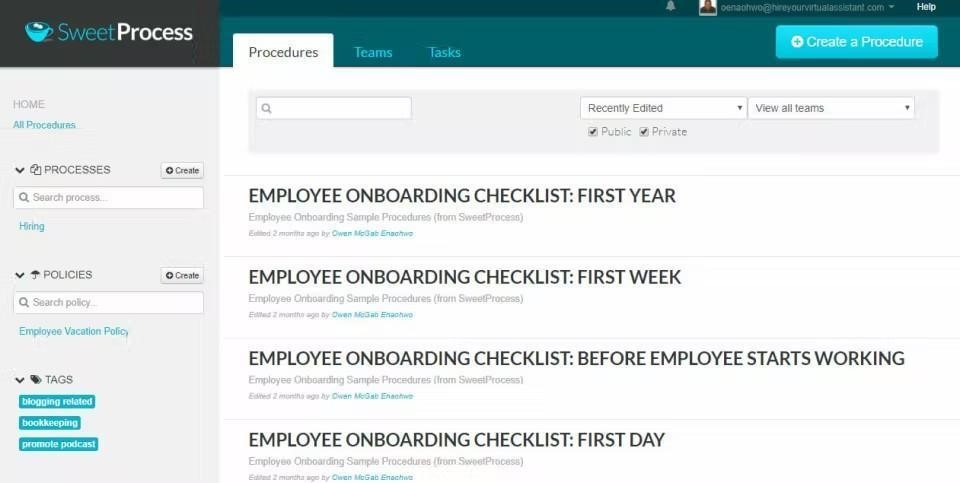
Image credit: capterra.com
SweetProcess is process management software designed to help businesses document, organize, and simplify their standard operating procedures (SOPs), policies, and business processes.
On SweetProcess’s user-friendly platform, users can create, share, and track step-by-step instructions, workflows, procedures, and policies within an organization.
It simplifies process documentation and management, allowing teams to collaborate effectively and improve business operations overall.
A thorough look into the features and functionalities of SweetProcess will help reveal how it truly compares to SharePoint.
Features of SweetProcess

- SweetProcess has a user-friendly interface that allows users to create and manage policies, business processes, standard operating procedures (SOPs), and workflows, with the ability to capture step-by-step instructions, including texts, images, videos, and other attachments.
- With SweetProcess, you can organize your documents into easy-to-follow hierarchical structures of folders, categories, and subcategories.
- Users can comment on procedures, suggest improvements, and provide feedback on documents and tasks in SweetProcess.
- With SweetProcess’s version control capabilities, you can track changes to process documents over time and quickly revert to previous versions if needed.
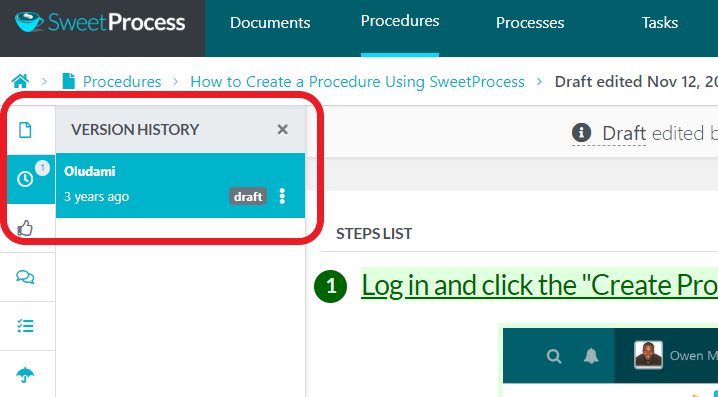
- You can assign tasks and responsibilities within processes and procedures documented in SweetProcess.
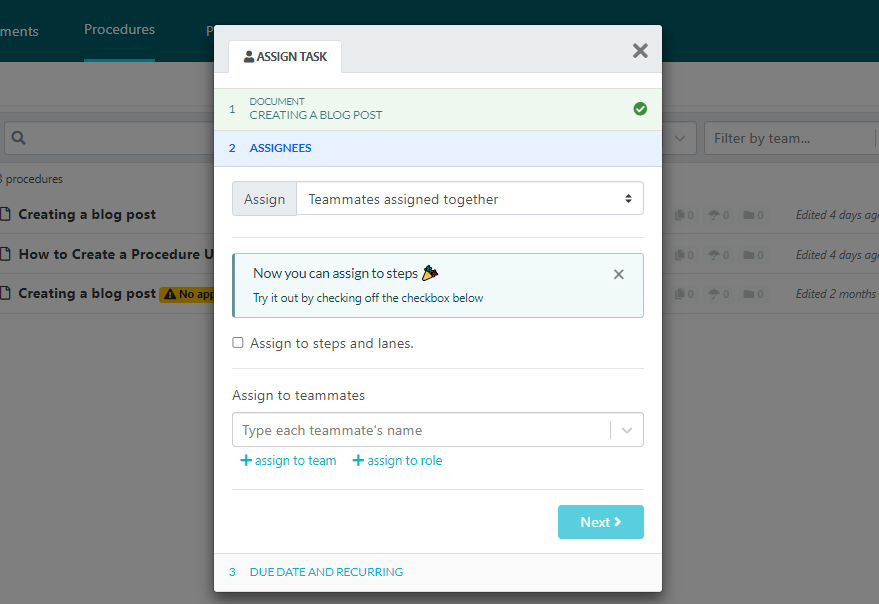
- You can also monitor and track team members’ progress on assigned tasks.

- SweetProcess sends notifications and reminders to team members to keep them updated on tasks, deadlines, progress, and process changes.
- With the search functionality of SweetProcess, users can quickly find specific processes or keywords within documents.

- You can set access control and permissions for different team members. This feature lets you specify which members can view, edit, or manage specific processes.
- SweetProcess automatically creates flowcharts as you document your procedures and processes.
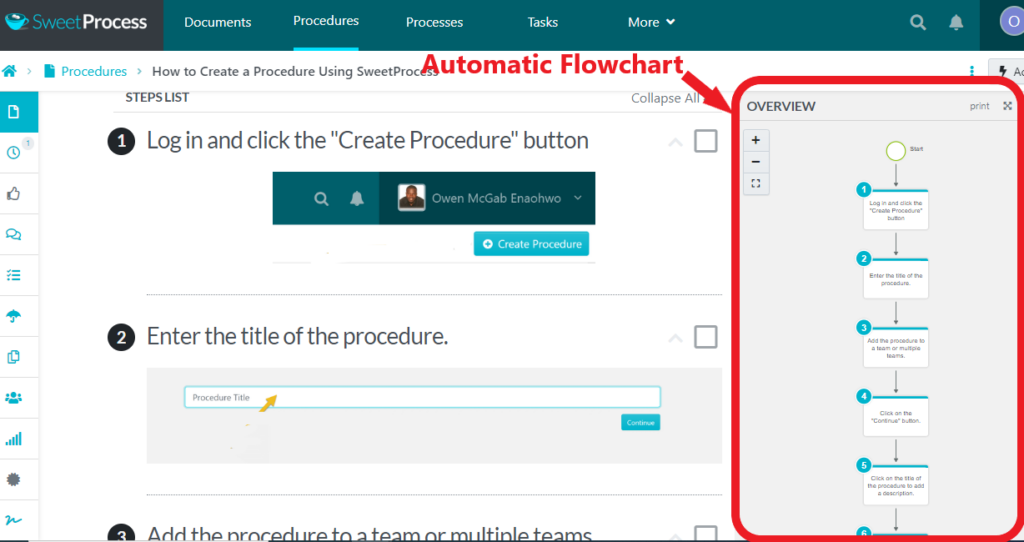
- SweetProcess integrates natively with third-party platforms, including popular ones like Slack, Quickbooks, Facebook, Zapier, and Google Drive.
- SweetProcess offers reporting and analytics features to track process usage and performance.
- SweetProcess offers pre-built process templates for standard business functions and industries. These templates can serve as a starting point for creating your processes and help you save time.
- SweetProcess can create a knowledge base with clear instructions and task completion guidelines. This can then be used to train new employees, team members, and clients/customers.
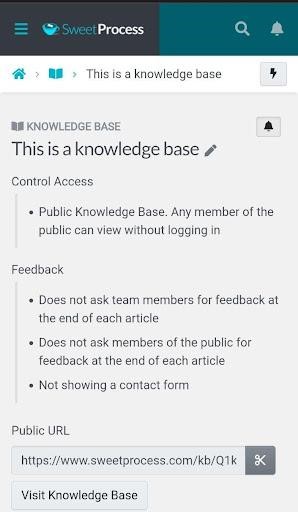
On a popular review site, a SweetProcess user said what they like best about SweetProcess is creating easy-to-navigate and visually appealing training documents and procedures and organizing them into a customizable knowledge base.
- SweetProcess has mobile apps for iOS and Android devices to allow users to access and manage documents on the go.
- SweetProcess maintains an audit trail of all document changes and updates, and this provides a level of security and compliance.
- SweetProcess provides customer support through various channels, including email, live chat, and knowledge base.
- SweetProcess also offers training materials, tutorials, and webinars to help users utilize its features and functionalities effectively.
- SweetProcess is flexible, designed to accommodate businesses of all sizes and industries, and therefore supports scalability.
- With SweetAI (SweetProcess’s resident AI), you can use artificial intelligence to generate your procedures and policies in SweetProcess instead of creating them from scratch.

This comprehensive list still doesn’t completely highlight everything SweetProcess can do for your business or organization.
A management consultant wrote in his verified review that his favorite SweetProcess features are its centralized SOP creation and organization, task delegation and progress tracking capabilities, and notification reminders. The reviewer said these features help businesses streamline processes, improve workflow, and hold team members accountable.
The best way to get a feel of SweetProcess’s capabilities is to try it yourself. The good thing is that SweetProcess offers a free trial.
You can try SweetProcess for free for 14 days by clicking here, just to see if it’s a good fit for your documentation needs. You don’t even need your credit card to get started.
From the features of SweetProcess listed above, we can easily see some pros you’ll get from being a SweetProcess user.
Pros of SweetProcess

- User-friendly interface and various media and file types provide clear and comprehensive documentation.
Another reviewer online said SweetProcess has almost no learning curve. That’s because you can jump right in and create procedures and processes. It’s easy to drag/drop items to rearrange them. You can also easily add more steps after you’ve put in the basics.
- SweetProcess’s hierarchical structure makes navigating and finding specific procedures, policies, or processes easy.
- The ability to contribute to documentation encourages collaboration among team members.
- Version-control feature ensures transparency.
- Tracking helps ensure accountability.
- Notifications and reminders help to improve communication and ensure that every team member stays informed and aligned.
- The search feature saves time and allows for easy retrieval of information.
- Access control ensures the right level of security and privacy.
- Integration with your existing third-party tools allows for seamless data exchange and workflow.
- Mobile apps ensure that users have the information they need at their fingertips, even on the go.

- SweetAI and pre-built templates help you quickly create policies, processes, procedures, and other documents.
- SweetProcess offers a free trial and a live demo to test things out before committing fully.
By now, you already know that SweetProcess is the ideal document management platform for your business. But let’s now examine a real-life scenario of how people use SweetProcess to streamline their operations and accomplish their business/organizational goals.
How Rise25 Organized Its Workflow With Effective Business Process Documentation

Rise25 helps businesses get clients through podcasting and other content marketing strategies.
Dr. Jeremy Weisz, the co-founder at Rise25, figured that having detailed standard operating procedures (SOPs) would help organize the many moving pieces involved in successfully launching and managing podcasts.
He and his team created a bunch of SOPs in Google Docs, but they couldn’t do much work with the unstructured files. Keeping up with the demand became a struggle, and it became apparent that their documentation system wasn’t of much help.
Even though Jeremy was initially skeptical about going from using a free system for so long to paying for one, they implemented SweetProcess to enhance their operations and meet demands.
Not only has SweetProcess streamlined its operations, but it has also increased its customer satisfaction levels.
“Within the first week or two, the team was like, ‘This is amazing. We can find things, and we can create processes,'” Jeremy says.
Some results that made Jeremy and his team happy with SweetProcess are:

- Documenting business processes and SOPs more effectively.
- Searchability helps employees find documents more efficiently.
- Referencing documents became easy. In Jeremy’s words: “The other thing that’s cool about SweetProcess is referencing another procedure within that procedure. It’s like, wait, at this step, you need to refer to this procedure. In Google Docs, we would track that procedure, find it, and link it. In SweetProcess, there’s a button that you can click to search for the process you’re looking for. It’s a click of a button. It’s so easy to deploy. It’s built into the design.”
- Document vetting and approvals by senior officials became automated. With SweetProcess, notifications are sent to the approving personnel for their input.
- Onboarding employees and clients became seamless, as they can use SweetProcess to create procedures for every step the client or employee needs to make the onboarding process as seamless as possible.
- Jeremy believes that creating a centralized knowledge base in SweetProcess is the biggest game-changer, as it gives him peace of mind. Operations are no longer put on a standstill when that employee who knows how to perform key tasks in your organization is indisposed for whatever reason.
Jeremy’s story reveals that there’s always room for improvement. Despite the difficulties of documenting their processes with basic tools like Google Docs, they were getting by. However their operations improved tremendously the moment they adopted SweetProcess.
Don’t deny your business the opportunity to grow.
SweetProcess offers a 14-day free trial with no credit card. Sign up for it and check it out yourself. If you aren’t satisfied by the end of your trial, you can simply walk away.
You can read Rise25’s full case study (or listen to Jeremy’s interview).
You can also click here for more case studies of how organizations use SweetProcess to make their business operations more effective.
By now, you’ve seen how SharePoint and SweetProcess compare generally. And you also now know which better suits your process management needs.
In the following chapters, we will compare both platforms against each other, specifically in the individual areas of documenting procedures, processes, and policies.
Before that, however, below is how SharePoint and SweetProcess compare:
SharePoint vs. SweetProcess at a Glance
| Features | SweetProcess | SharePoint |
| Process Management | Streamlined process documentation | Broad collaboration and content management |
| Visual Workflows | Visualize workflows for clarity | Limited workflow visualization |
| Simplicity | Intuitive interface for easy adoption | Complexity and learning curve |
| Focused Solution | Dedicated to process documentation | Multi-purpose collaboration platform |
| External Sharing | Share processes with clients and partners | Limited external sharing capabilities |
| Process Mapping | Visualize and map out processes | Limited process mapping features |
| Customization | Tailor processes to specific needs | Extensive customization options |
| Mobile Accessibility | Access and collaborate on processes on the go | Mobile access for broader collaboration |
| Ease of Implementation | Quick setup and deployment | Potentially complex deployment |
| Cost-Effectiveness | Affordable pricing plans | Variable costs depending on deployment |
| Focused Support | Specialized support for process management | Generalized support for various features |
| Free Trial | Full-featured 14-day trial | The trial period may vary |
From the general comparisons we’ve done so far, you can readily tell that SweetProcess is the better of both process management and documentation platforms. This comparison table makes it even more glaring.
The next question is: How do these platforms compare in documenting policies specifically?
SharePoint vs. SweetProcess: Documenting Policies
A policy is a high-level statement that outlines the organization’s rules, principles, and guidelines to get results in specific areas.
How can SharePoint and SweetProcess both help to document and manage your policies effectively?
Let’s start with SharePoint.
How to Document Policies Using SharePoint
1. Log in to your SharePoint environment and navigate to the SharePoint site or subsite dedicated to policy documentation.

2. Select a document library within the site where you’ll store the policy document. You can use an existing library or create a new one if needed.

3. click the “New” button to create a new document in the chosen document library. Choose the appropriate document type, such as Microsoft Word or the SharePoint document editor.

You can also upload or drag and drop existing documents into the library.
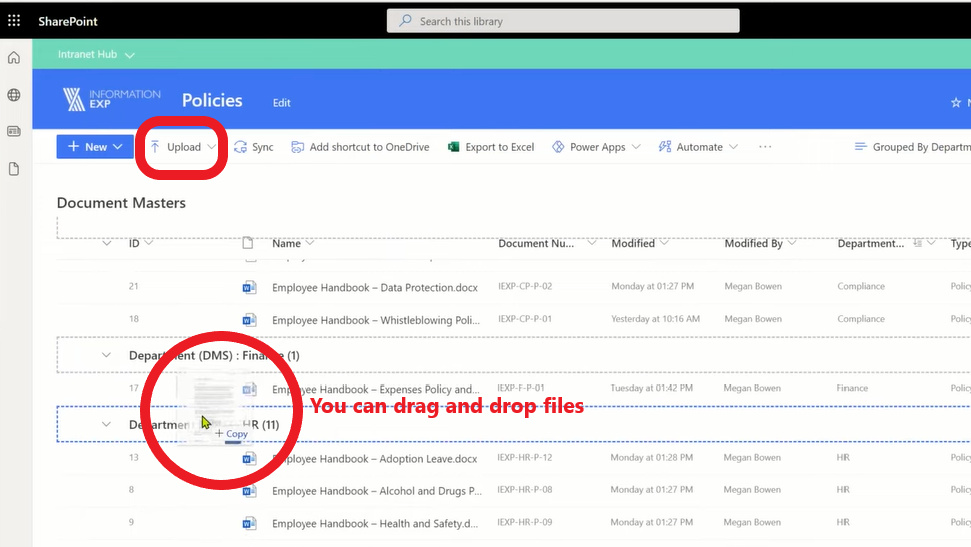
4. Begin the document with a clear and descriptive title for the policy. Include a brief description of the policy’s purpose and importance.
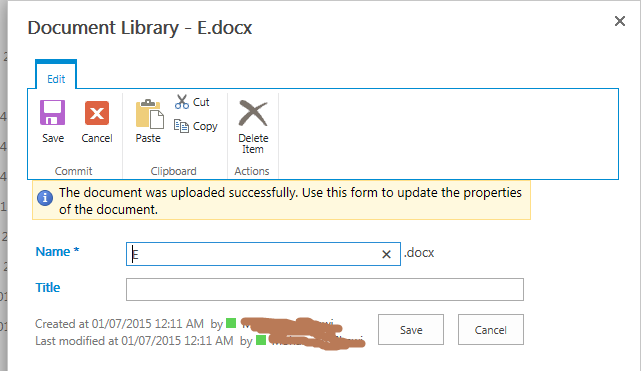
Image credit: StackExchange
5. Use headings and subheadings to organize the content into logical sections. This makes it easier for readers to navigate and understand the policy.
6. Configure versioning settings for the document library to track changes and maintain a revision history of the policy document.
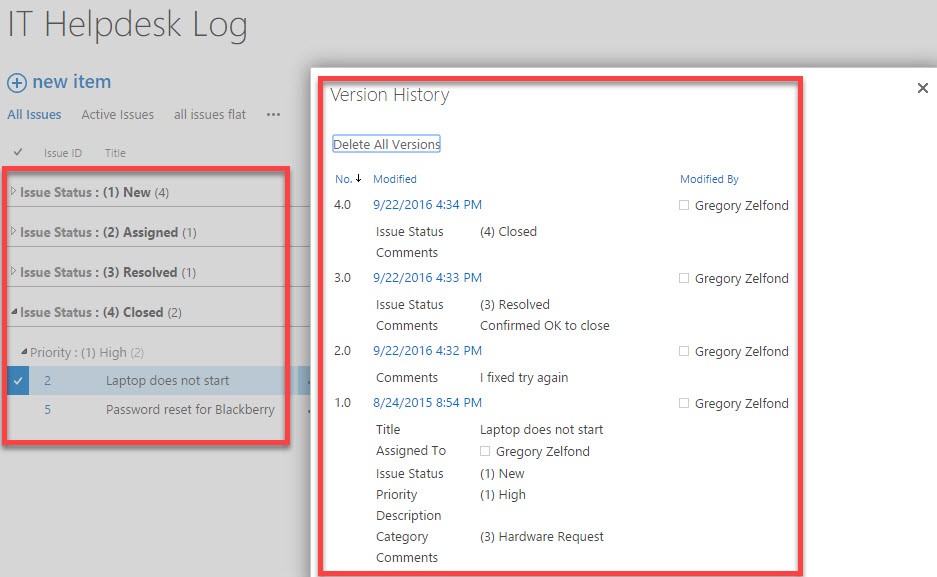
Image credit: SharePoint Maven
7. Incorporate metadata fields such as policy owner, effective date, department, and keywords. Metadata enhances searchability and categorization.

You can also add tags for categorization and easy finding.
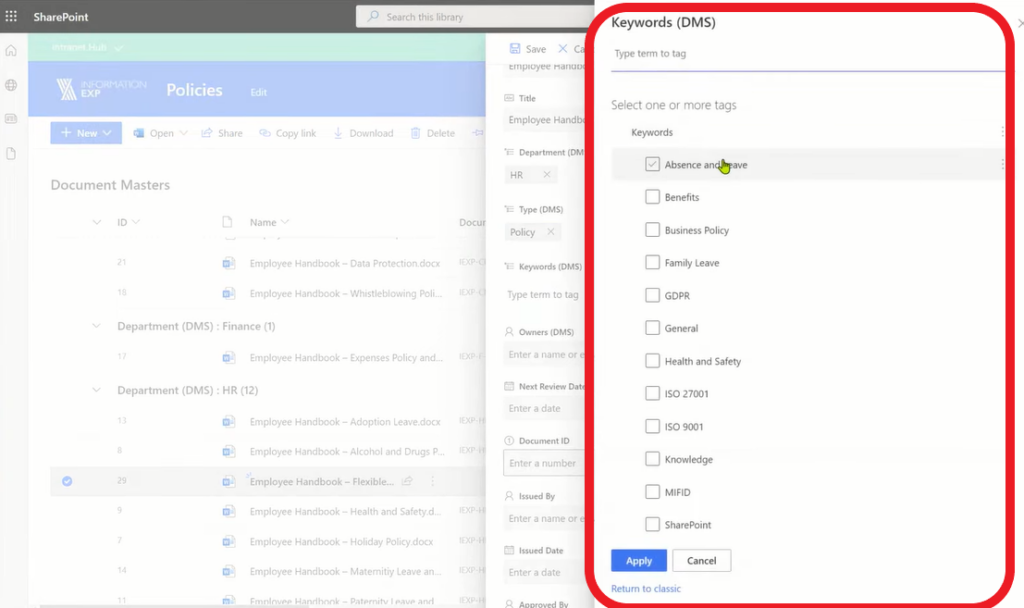
8. Share the document with relevant stakeholders and contributors for feedback and review. Assign appropriate permissions or send direct links for access.
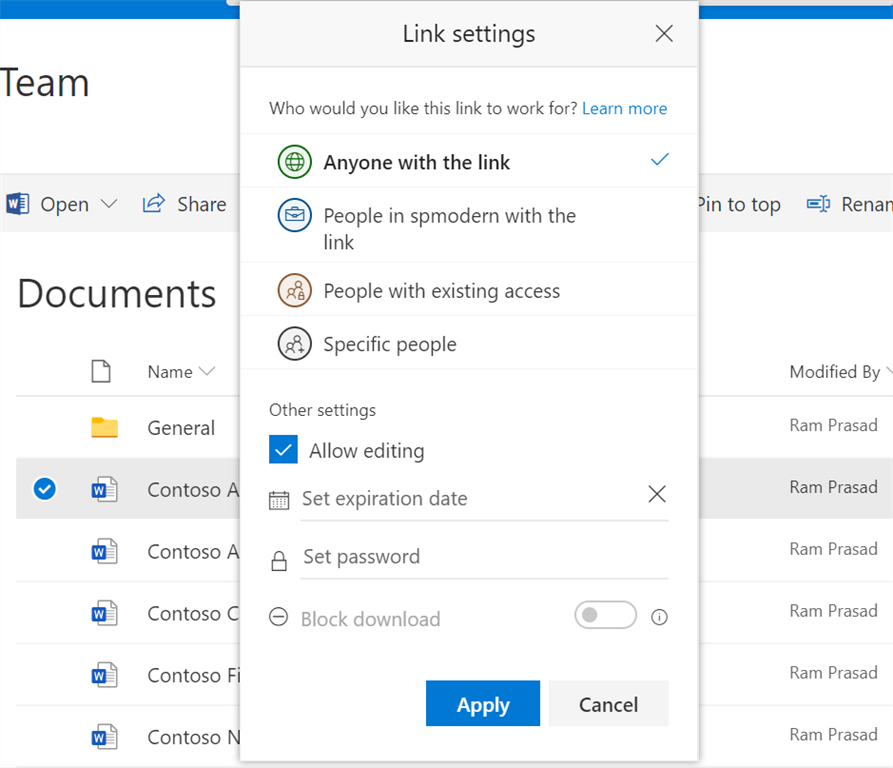
Image credit: C#Corner
9. Implement an approval workflow that guides the policy document through a review and approval process. Define the workflow steps and designated approvers.


10. Establish a routine schedule for reviewing and updating the policy document to ensure its accuracy and relevance.
These are the major steps in documenting policies in SharePoint. Now, let’s examine how to document policies using SweetProcess.
Documenting Policies in SweetProcess
When documenting policies in SweetProcess, the process is far more straightforward than on SharePoint.
1. From your SweetProcess homepage, click the “More” dropdown button and select “Policies”.
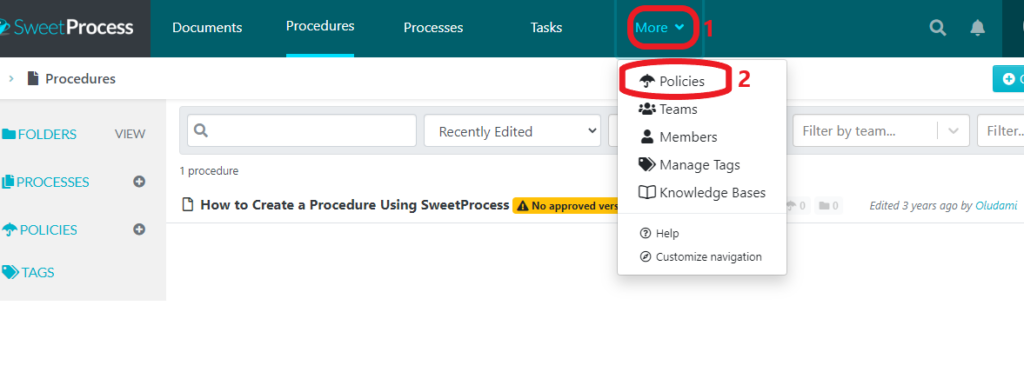
2. click the “Create a new policy” button to create your policy from scratch. Or click the dropdown button at the top-right corner (beside “Create Policy”) and click on “Upload document” if you already have your policy in a Word document (.DOCX).

3. On the next page, enter your policy title and, if you so desire, add the policy to teams and folders. Next, click on “Continue” to get to the editor.
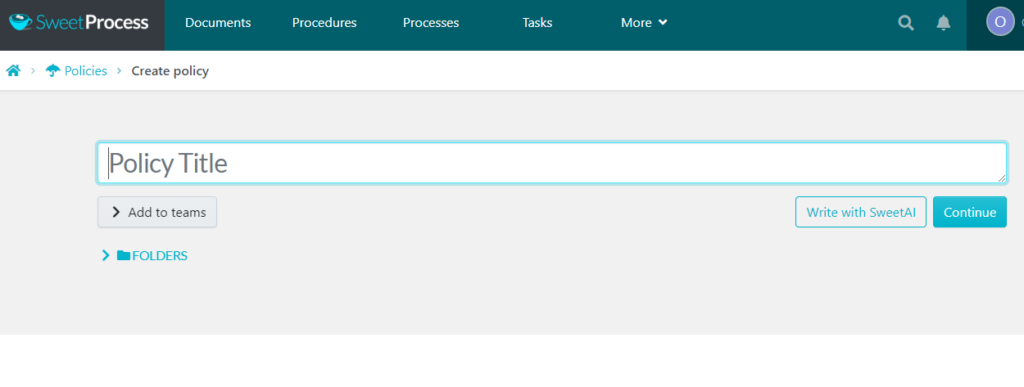
Or you can click on “Write with SweetAI” to let SweetProcess AI write the content for you based on your title.
4a. If you make SweetAI write your policy, you get something like this (generated based on the title “Recruiting” ):

4b. Otherwise, if you click “Continue” instead, you’ll be taken to the policy page, where you can edit the policy to add content.
Note, however, that you’ll still get a prompt encouraging you to have SweetAI write your policy on the policy page.
This is good when you don’t have your policy content ready; you can just edit the AI-generated policy.
5. If you already have your content, you can ignore the prompt and click “Click here to edit policy content.”
6. This action immediately opens up the policy content editor, where you can write or paste your policy content.

With this editor, you can include pictures, videos, links, and tables. You can also embed a video on the page or attach an external file to the policy.
7. When you’re done, click the “Save changes” button to save your policy content.
8. Next, the new policy needs to be approved. Simply click on the “Approve” button at the top-right corner of the screen.

If you’re a team manager or super manager, you’ll automatically be able to approve the draft. Otherwise, you must request approval so that whoever has the authority can go into the policy to approve it.

And that’s the entire process of creating a policy on SweetProcess.
You can see how straightforward it is—Unlike in SharePoint, the tabs, buttons, and sections are readily presented and appropriately named, making creating policies (or anything) in SweetProcess extremely simple.
You’ve seen how both platforms document policies. Next, let’s see how they both document processes.
SharePoint vs. SweetProcess: Documenting Processes

Processes provide a broad framework for decision-making and set the direction for how an organization should act in specific situations or areas.
It’s crucial for you to document processes for your organization.
What functionalities do SharePoint and SweetProcess have to help you document and manage processes?
How to Document Processes Using SharePoint
The general steps for creating and documenting other types of content, like processes in SharePoint, are pretty similar to the steps outlined earlier for documenting policies. The main differences will lie in the specific content and details you include in each type of document.
The other difference is that you can create and house your processes in a document library you specifically create for processes inside SharePoint.
In other words, to create your processes inside SharePoint, create a separate document library for your processes and follow the earlier steps outlined under policies.
It’s a different story with SweetProcess, however. Each document type has its own tab and page already existing in SweetProcess. And even though the steps for creating each document are similarly simple, each type of document reflects its own uniqueness and differences—and, of course, has its own separate house.
Below are the steps to create processes in SweetProcess:
1. Click “Processes” from the navigation menu (or dropdown on mobile).
2. Next click on “Create Process.”

3. Enter the title of the process.

4. Click on a checkbox to add the process to a team or on multiple checkboxes to add the process to multiple teams at the same time. (If you don’t have a team yet, you can create one once you click on the “Add to teams” dropdown.)

5. Click on the title of the process to add a description.

6. Click on the “Continue” button.

7. You’ll be taken to the editing page. Simply click “Add Step” to start adding the steps in your process.

8. Choose from the popup the kind of step you want to add. It could be “Procedure,” “Decision,” or “End Step.”

9. Whichever you choose, an editor will open up where you can input text, images, videos, links, etc. You can also add tags at this stage. Once you’re done editing and are satisfied, click on “Finished editing.”
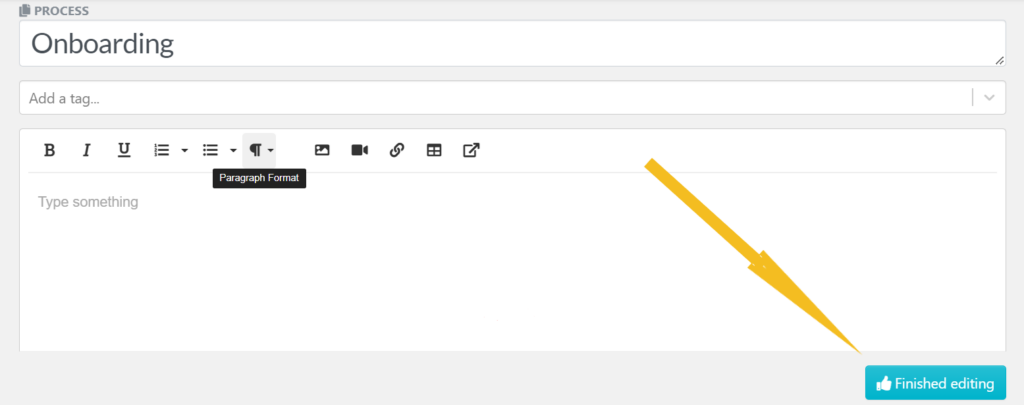
10. Repeat steps 7, 8, and 9 until your process is complete.
11. Add an end step.
12. Save the draft and review it as you want. Don’t forget to approve your draft when you’re all done. That’s when it goes live.

And now you have a brand-new process!
How can documenting your processes on SweetProcess help you improve your business operations? Let’s examine a quick case study to get answers.
How TechQuarters Overcame Tribal Knowledge by Creating Effective Business Processes and Procedures
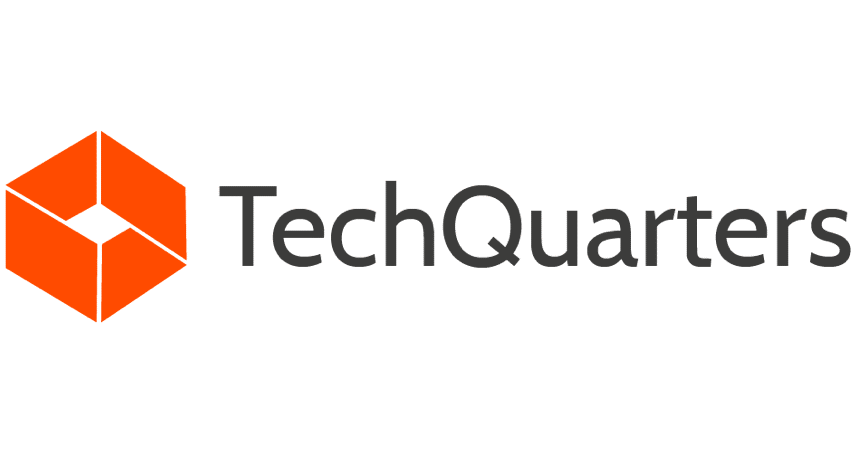
As TechQuarters grew, CEO Chris Dunning and Operations Director Mark O’Dell realized that tribal knowledge was causing more harm than good to their organization. Obviously, they would achieve better results if they had all their business processes and procedures in a central system accessible to everyone on their team.
While searching for the right tool for the job, they found SweetProcess. Not only were they able to distribute knowledge among their team members evenly, but they were also able to create a more efficient workforce.
According to Chris and Mark, below are a few ways SweetProcess has impacted TechQuarters:
1. With an array of documentation features in SweetProcess, they could create comprehensive and easy-to-use processes and procedures that employees were happy to use because they made their jobs easier.
“What you find is that something will go wrong, and we look back then, and one of the teams will say, could we add this to SweetProcess? If this had been done, I wouldn’t have had this problem further down the line, and each individual would look at it and go, ‘Oh yeah, great.’ And the next time around, problem solved, because we do this extra step in the process.”
2. Because all processes and procedures are now documented inside SweetProcess, new and established employees can access any work instructions needed to be efficient at their jobs.
3. Now that their business processes and procedures are systematized, they can deliver perfectly to customers. And this leads to improved customer satisfaction.
4. Employees are as good as the quality of training they get. And thanks to SweetProcess, TechQuarters is able to empower employees with the information and resources to perform well.
5. Document versioning can be confusing using manual documentation, as team members could easily mix them up. But with SweetProcess, each process version is spelled out for easy access and tracking.
Doubling their business in the next two to three years is top on Chris and Mark’s list, and they are going all out for it with SweetProcess in hand.
If you have been thinking about streamlining your business, you must follow Chris and Mark’s steps. They were able to empower their employees and increase their customers’ satisfaction by implementing SweetProcess.
The good thing is that SweetProcess offers a 14-day free trial, and no credit card is required. Sign up now, and if you aren’t convinced by the end of your trial, you can simply take a walk.
You can click here to read TechQuarters’ full case study or listen to Chris and Mark’s interview. You can also click here to find more SweetProcess case studies.
Next, let’s examine how both platforms in review compare against each other when it comes to documenting procedures.
SharePoint vs. SweetProcess: Documenting Procedures

A procedure is a set of step-by-step instructions that describe in detail how specific tasks and organizational activities should be performed. These are important for maintaining an organization’s quality, compliance, and operational effectiveness.
To this end, an organization must ensure they have the best tools for creating procedures that will help them ensure consistency and efficiency.
How do both SharePoint and SweetProcess fare when it comes to documenting procedures? How do they stack up against each other? Let’s examine them individually.
How to Document Procedures Using SharePoint
As said earlier, to document your procedures using SharePoint, create a document library specifically for procedures and then follow the steps highlighted under “how to document policies using SharePoint.”
Remember, the main difference between your procedures and other documents on SharePoint will be in the details you include in your procedure.
And as you already know, the case is different with SweetProcess.
How to Document Procedures Using SweetProcess
Even though the steps to create a procedure are as simple as the steps of a policy, each documentation has its own designated section where it’s created and housed.
In SweetProcess, there are separate tabs (and navigations) for procedures, policies, tasks, processes, knowledge bases, and even “documents” (for other documentation).
Another great thing about this is that you can customize your navigation tabs to arrange them in your preferred order.
Having clarified this, below are the steps for documenting standard operating procedures (SOPs) inside SweetProcess.
1. The default SweetProcess page is usually the Procedures page. You can simply click on the “Procedures” menu and be taken to the Procedures page from wherever you are inside SweetProcess.

2. click the “Create Procedure” button at the top-right corner on the Procedures page. If you want to upload an existing procedure, click the dropdown button instead and click on “Upload document.”

3. Next, add a title to your procedure. This will help you find it easily later.

On this page, you can add the procedure to teams and also add it to folders.
4. After you’re done, you can click on “Continue” or “Write with SweetAI.”
5. If you click on “Continue,” it takes you to the editor, where you can enter the content of your procedure. If you click “Write with AI,” SweetAI will write out your procedure based on your title.

You can then edit the AI-generated content as you wish.
If you click “Continue” after entering your title instead of employing SweetAI, you’ll be taken to the page where your procedure can be edited.
6. Next, click on “Step” to add a step.

7. Give the step a title and fill in your procedure content.
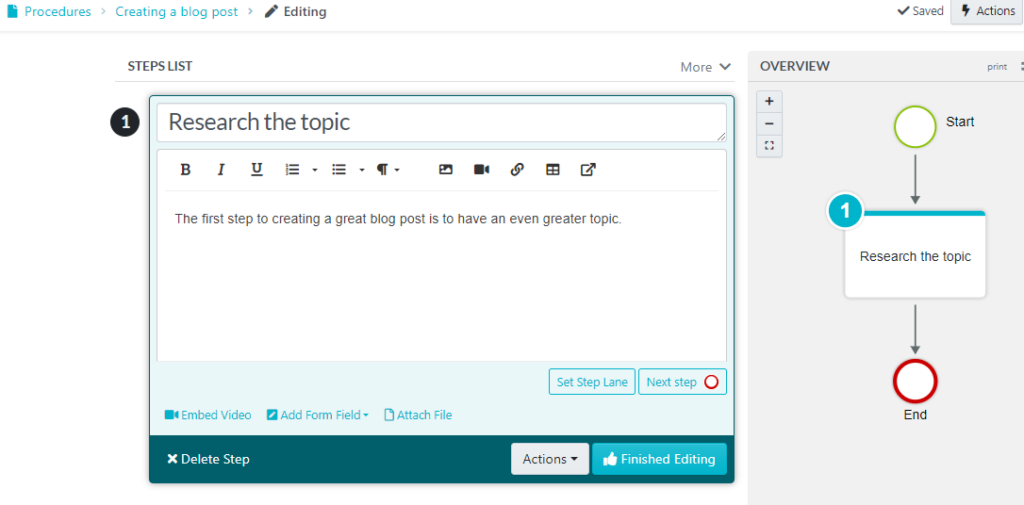
You can attach images, videos, links, tables, and other files in this editor. You can also embed videos.
8. When you’re done, click on “Finished Editing.”

9. You can use the “Step” button to add as many steps as required to complete your procedure.
10. Once your procedure is complete, click the “Approve” button if you have such permission.

If not, click the dropdown button and click on “Request Approval” so that whoever has such permission can approve the procedure.
Those are the simple steps to creating a procedure in SweetProcess.
Remember that you can always easily find your procedures by clicking on the Procedures tab in the navigation menu of your dashboard.
This individual autonomy makes a big difference between SweetProcess and most other business process management platforms—apart from how much easier and simpler documentation is on SweetProcess generally.
What can you expect from documenting and managing your procedures with SweetProcess? How about another quick case study?
How Spark Marketer Boosted Employee Confidence With Standard Operating Procedures (SOPs)

After abandoning his music career for marketing, Carter Harkins, co-founder of Spark Marketer, and his business partner began to record some success in providing marketing services to chimney businesses.
They, however, had one big problem: a lack of documentation. Employees depended on tribal knowledge to get things done—an approach that resulted in disorganization in the workplace.
One meeting with a business consultant opened their eyes to the operational loopholes they were oblivious to in their business. They had been working without standard operating procedures (SOPs) and had no idea what they meant.
The absence of these SOPs created a lack of confidence in employees’ performances since any operational standards did not guide them.
These driven partners eventually adopted a system to create SOPs and streamline their business operations.
They started with Google Docs, but as their business began to grow, they realized that Google Docs were insufficient to sustain their growth.
Carter heard about SweetProcess through a podcast where the founder, Owen, was being interviewed, and he was fascinated with all that the software could be used for in business.
He signed up for a free trial immediately and got hooked on SweetProcess. He has been subscribed to it ever since.
Some benefits of adopting SweetProcess that the team at Spark Marketer has been enjoying are:
1. Simplified process documentation
2. Decentralized knowledge base
3. Seamless employee training
4. Effective change management. Team members are up-to-speed with the latest updates rather than being kept in the dark.
Scaling their business is top on the list for Carter and his team, and they are banking on streamlining their business with SweetProcess to facilitate their expansion.
Do you want to improve your business operations? Sign up for a 14-day free trial of SweetProcess today to get started. You do not even need a credit card for the trial.
You can click here to read the full Spark Marketer case study. And if you’d like to learn how other organizations are using SweetProcess to streamline their operations and grow their businesses, then click here to find dozens of case studies.
Why Organizations Choose SweetProcess Over SharePoint

By now, you’ve seen how much SweetProcess outperforms SharePoint, especially in creating and managing policies, procedures, and processes.
You’d agree that no other process management software comes close to SweetProcess when you consider its features, advantages, and the results organizations have gotten from using it.
Over 40,000 businesses choosing SweetProcess and sticking to it over the years cannot be wrong, right?
Why exactly do these organizations choose SweetProcess?
Instead of reviewing another list of amazing SweetProcess features, we can get the answer directly from some of these organizations.
Below is a video interview where Sarah Genay, the portfolio analytics manager at Ginkgo Residential, reveals how she was tasked with overseeing the documentation of business processes at the company and how SweetProcess has helped.
Their goal was to streamline their workflow and enhance employee efficiency, but there was only so much they could achieve with PDF manuals. Keeping the manuals up to date with the latest processes in their organization was a challenge.
Sarah began searching for the right system to do the job more effectively. After trying out several options on the market, she picked SweetProcess, and they could synchronize their processes in one fold.
As president and financial advisor at Thimbleberry Financial, Amy Walls leads a team of financial experts who help clients manage and grow their money for a purpose.
Because standard processes are integral to an organization’s success, Amy created business processes in Microsoft Word to enhance their operations. However, her team had difficulty accessing the information they needed to perform their tasks.
When Amy’s business coach recommended SweetProcess, she was initially reluctant to use it. But her reluctance soon changed to excitement.
In the video below, Amy talks about how SweetProcess has helped her grow a more efficient team and streamline the operations at Thimbleberry Financial.
On how SweetProcess has impacted their business, Megan Tully, director of BPM at Synergy Billing, said: “SweetProcess is not only cost effective, but it gives you the ability to scale your business and grow.
It gives you the tools and resources to scale…and gives you the data to make data-driven decisions for your company.”
How Benchmark Wealth Management Streamlined Its Operations With the Right Process Documentation Software

With a strong team of financial experts, Benchmark Wealth Management, a financial advising firm, was growing at lightning speed using a team-based approach to financial planning.
But there was a missing piece in its operations puzzle: They had no universally accepted standard operating procedures, so employees performed their tasks differently.
This made it obvious that they weren’t ready for their emerging growth.
With a relentless spirit and a strong determination to maximize their growth opportunities, the Benchmark Wealth Management team set out to find a software application to document their processes.
They soon discovered SweetProcess (a stumble, actually), and not only did it help the organization to streamline its operations, it also made its team members more efficient at their jobs.
Branch operations manager Sarah Beach and certified financial planner Elian Levatino, who are both part of the leadership team at Benchmark Wealth Management, shared specific ways SweetProcess has improved the organization’s operations:
1. Employee Onboarding: After moving away from instructors using notebooks in the employee onboarding process, SweetProcess now helps the organization streamline the onboarding process with current information even before onboarding begins.
2. Document Effective Processes: Rather than just documenting processes, SweetProcess provides a platform for the team to confirm that documented processes are actionable and usable.
3. Employee Independence: Before SweetProcess, the team had several question-and-answer sections discussing what to do and how to do it. But with SweetProcess, the questions are almost non-existent.
Documenting processes has brought about a significant change in the daily operations of the Benchmark Wealth Management leadership team.
Now they can focus on their ambitions to grow and their commitment to being purposeful and positively impacting people’s lives.
You can click here to read the full Benchmark Wealth Management case study and also listen to the interview with Sarah and Elian. And you can also click here to find more SweetProcess case studies.
Do you need help with streamlining your business operations too?
Sarah described SweetProcess as “a great stumble.” You don’t have to wait until you stumble on it. Take the initiative to sign up for a 14-day free trial right away. You don’t need a credit card for that. You can easily walk away at the end of your trial if you aren’t impressed.
Conclusion
Now you’ve seen their features, pros and cons, and how they generally stack against each other. Using these platforms, you now know how to document and manage your policies, procedures, and processes.
More so, you’ve learned about their experiences with these platforms from other users, including reviews, testimonials, and case studies.
This implies that you’re now empowered to make an informed decision on the business process management software to streamline your organization’s operations.
The ideal next step is to try these platforms to see which fits your organization perfectly.
The good news is that SweetProcess gives you two distinct opportunities to try their platform.
Firstly, if you want to get a quick feel of SweetProcess before committing, simply click here to demo SweetProcess for free. You won’t even need to fill out any forms.
Secondly—and more importantly—you can start using SweetProcess today to document and manage your processes for free for the next 14 days.
That will be enough time to know if it’s a good fit for your organization.
You only start making payments if you want to continue using SweetProcess after your 14-day trial expires. We don’t need your credit card on file until you’re convinced, happy, and ready to move forward with SweetProcess after the fourteenth day.
We are this confident because over 40,000 other organizations have tried SweetProcess and haven’t looked back, and that’s why we are happy to give you access to ALL our features for free.
Click here to get started with SweetProcess immediately.
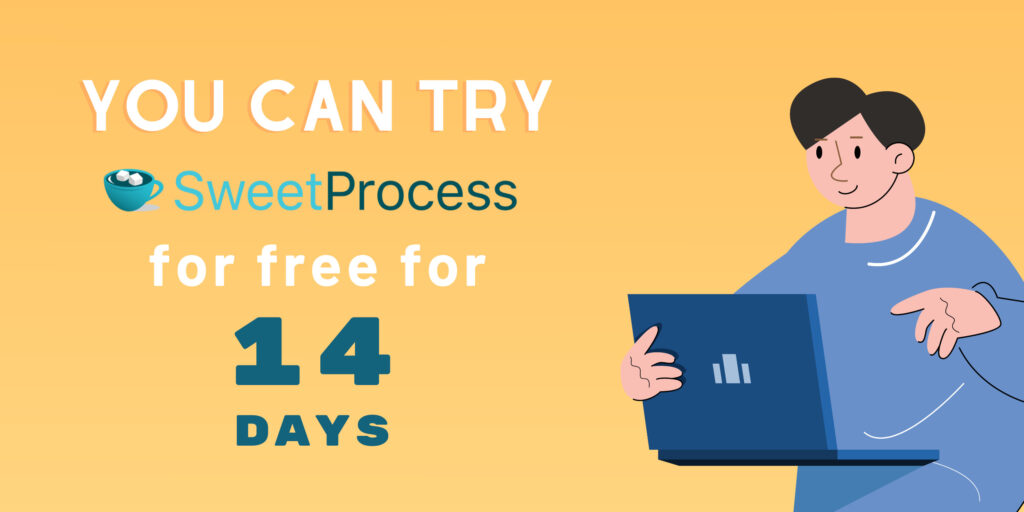
Sources:
https://www.getapp.com/collaboration-software/a/sharepoint/reviews/
https://www.g2.com/products/microsoft-microsoft-sharepoint/reviews
https://www.trustradius.com/products/microsoft-sharepoint/reviews?#overview
https://www.softwareadvice.com/cms/microsoft-sharepoint-profile/reviews/
https://bloomfire.com/knowledge-hub-article/disadvantages-of-sharepoint/